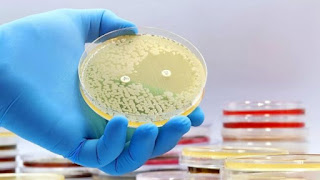بە یارمەتی زیرەکی دەستکرد زاناکان دوای ٦٠ ساڵ توانیان دژە زیندەیی یان ئەنتی بیوتیک نوێ بدۆزنەوە.
زیرەکی دەستکرد گۆڕانکاری بنەڕەتی لە زانستی پزیشکیدا دەکات و لە یەکێک لە دوایین سەرکەوتنەکانیشدا، دوای ٦٠ ساڵ، زاناکان توانیان پۆلێکی نوێی دژە زیندەیی بدۆزنەوە کە توانای کوشتنی ستافیلۆکۆکۆسی ئاوریۆس یان MRSAی هەیە.
ئەم بەکتریایە کە بەرگرییەکی زۆری هەیە بەرامبەر بە دەرمان، ساڵانە هەزاران کەس لە جیهاندا دەکوژێت و هەر لەبەر ئەم هۆکارەش دۆزینەوەی ئەم دژە زیندەییە بە خاڵی وەرچەرخان دادەنرێت لە بەرەنگاربوونەوەی بەرگری بەکتریادا.
جەیمس کۆلینز، مامۆستای ئەندازیاری بایۆپزیشکی لە زانکۆی MIT و ئەندامی تیمی توێژینەوەکە دەڵێت: "بیرۆکەکە هەڵسەنگاندنی توانای مۆدێلەکانی [ژیری دەستکرد] بوو بۆ پێشبینیکردنی ئەوەی کە هەندێک مۆلیکول دژە زیندەیی باش دەبن". بەکارهێنانی زانیاری زیرەکی دەستکرد دەبێتە هۆی پاشەکەوتکردنی هەم کات و هەم سەرچاوە، هەروەها دەبێتە هۆی شیکردنەوەی بەکتریا و پێکهاتە کیمیاییەکانیان بە شێوەیەک کە پێشتر نەدەکرا.
ڕاپۆرتی دەرئەنجامەکانی ئەم تیمە ٢١ کەسییە لە گۆڤاری سروشتدا بڵاوکراوەتەوە و لەم توێژینەوەیەدا توێژەران "مۆدێلی فێربوونی قووڵ"یان بەکارهێناوە بۆ پێشبینیکردنی چالاکییەکان و هەروەها پێکهاتەی ئەم دژە زیندەییە نوێیە.
فێربوونی قووڵ ڕێگە بە زیرەکی دەستکرد دەدات فێربێت و بیرۆکەی نوێ بدۆزێتەوە لە کۆمەڵەیەکی گەورەی داتای بێ بەرنامە. ئەم شێوازە لە توێژینەوە پزیشکییەکاندا زیاتر بەکاردەهێنرێت بە ئامانجی دەستنیشانکردنی دەرمانە ئەگەرییەکان و پێشبینیکردنی تایبەتمەندییەکانیان و باشکردنی پرۆسەی گەشەپێدانیان.
ئەو هەوکردنانەی کە بەهۆی ستافیلۆکۆکۆسی ئاوریۆسەوە دروست دەبن کە بەرگری لە داروینیس دەکات، دەتوانێت لە هەوکردنی سوکی پێستەوە دەست پێبکات تا حاڵەتی جددیتر و مەترسیدارتر بۆ سەر ژیان وەک هەوکردنی سییەکان و هەوکردنی خوێن.
ڕاپۆرتی سەنتەری ئەوروپی بۆ خۆپاراستن و کۆنترۆڵکردنی نەخۆشیەکان (ECDC) ئاماژە بەوە دەکات کە ساڵانە نزیکەی ١٥٠ هەزار تووشبوون بەم پەیوەندییە لە سەرانسەری یەکێتی ئەوروپادا ڕوودەدەن و ساڵانە نزیکەی ٣٥ هەزار کەس لەم یەکێتییەدا لە ئەنجامی ئەم تووشبوونانە دەمرن.
تیمی لێکۆڵینەوەی MIT بە هاوکاری "مۆدێلی فێربوونی قووڵ" نزیکەی 39 هەزار ئاوێتەیان هەڵسەنگاند بۆ زانینی چالاکی دژە زیندەییەکانیان لە دژی بەکتریا "Staphylococcus aureus" و داتا و وردەکارییەکانی دەستکەوتوویان سەبارەت بە پێکهاتەی کیمیایی پێکهاتەکان خستە ناو ئەم مۆدێلە.
فێلیکس وۆنگ، توێژەرێکی دیکەی توێژینەوەکە دەڵێت: "ئەوەی ئێمە ویستمان لەم توێژینەوەیەدا بیکەین، جۆرێک بوو لە کردنەوەی سندوقی ڕەش". "ئەم مۆدێلانە حیساباتی زۆریان تێدایە کە لە ڕاستیدا پەیوەندییە دەمارییەکان تقلید دەکەن و کەس بەڕاستی نازانێت لەناو ئەو سندوقەدا چی ڕوودەدات."
توێژەران دەڵێن بە یارمەتی ئەم مۆدێلانە توانیویانە نزیکەی ١٢ ملیۆن ئاوێتە هەبوون سکرین بکەن و ئاوێتە لە پێنج پۆلی جیاواز دەستنیشان بکەن کە جۆرێک لە چالاکیی دژی بەکتریاکانی ستافیلۆکۆکۆسی ئاوریۆس نیشان دەدەن.
دوای ئەوە توێژەران نزیکەی ٢٨٠ لەو پێکهاتانەیان لە دژی بەکتریای "Staphylococcus aureus" تاقیکردەوە و لە کۆتاییدا توانیان دوو پێکهاتەی دژە زیندەیی ئومێدبەخش دەستنیشان بکەن.
پشکنینی کۆتایی بۆ کاریگەری ئەم دژە زیندەییە لەسەر دوو مۆدێلی مشک ئەنجامدرا، گروپێکیان هەوکردنی پێستیان بە "Staphylococcus aureus" و گروپەکەی تریان هەوکردنی سیستماتیکی "Staphylococcus aureus"یان هەبوو و ئەنجامەکان دەریانخست کە بەکارهێنانی ئەمە ئانتیبایۆتیکێکی نوێ بووە هۆی کەمبوونەوەی ڕێژەی هەوکردنەکان لە نێوان مشکی خانەخوێدا تا ١٠ هێندە کەم ببێتەوە.
With the help of artificial intelligence, scientists were able to discover a new antibiotic after 60 years.
Artificial intelligence is making fundamental changes in medical science, and in one of the latest successes, after 60 years, scientists were able to discover a new class of antibiotics capable of killing Staphylococcus aureus, or MRSA.
This bacterium, which is highly resistant to drugs, kills thousands of people worldwide every year, and for this reason, the discovery of this antibiotic is considered a turning point in the fight against bacterial resistance.
"The idea was to evaluate the ability of [artificial intelligence] models to predict that certain molecules would be good antibiotics," says James Collins, a professor of biomedical engineering at MIT and a member of the research team. The use of artificial intelligence knowledge will save both time and resources, and will enable the analysis of bacteria and their chemical structure in a way that has not been possible before.
The report of the findings of this 21-member team has been published in the journal Nature, and during this research, the researchers used a "deep learning model" to predict the activities as well as the composition of this new antibiotic.
Deep learning allows artificial intelligence to learn and discover new ideas from a huge collection of unprogrammed data. This method is increasingly used in medical research with the aim of identifying potential drugs, predicting their properties and optimizing their development process.
Infections caused by Staphylococcus aureus, which is resistant to Darwinis, can range from mild skin infections to more serious and life-threatening conditions such as pneumonia and blood infections.
The report of the European Center for Disease Prevention and Control (ECDC) indicates that every year about 150,000 infections occur in this connection throughout the European Union, and about 35,000 people die each year in this union as a result of these infections. .
The MIT research team evaluated about 39 thousand compounds with the help of "deep learning model" to know their antibiotic activities against "Staphylococcus aureus" bacteria and entered the data and details obtained regarding the chemical structure of the compounds into this model.
"What we wanted to do in this study was kind of open the black box," said Felix Wong, another researcher on the study. "These models involve a lot of computation that actually mimics neural connections, and nobody really knows what's going on inside that box."
Researchers say that with the help of these models, they were able to screen about 12 million existing compounds and identify compounds from five different categories that show some kind of activity against Staphylococcus aureus bacteria.
After that, the researchers tested about 280 of these compounds against the bacteria "Staphylococcus aureus" and finally they were able to identify two promising antibiotic compounds.
The final tests for the effectiveness of these antibiotics were performed on two mouse models, one group of which had a skin infection of "Staphylococcus aureus" and the other had a systemic infection of "Staphylococcus aureus" and the results showed that the use of this new antibiotic caused the rate of infections to decrease. among the host mice to decrease up to 10 times.




















.jpg)






0 Post a Comment:
ارسال یک نظر